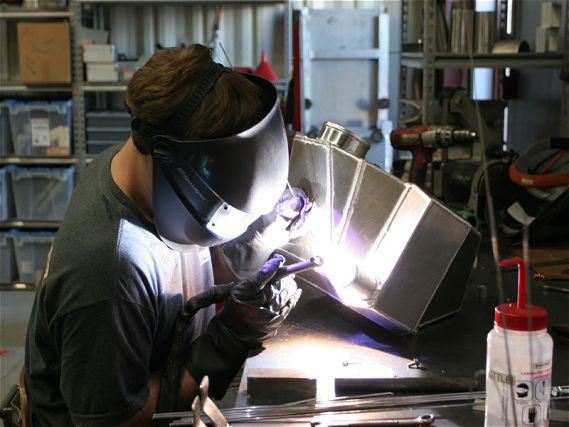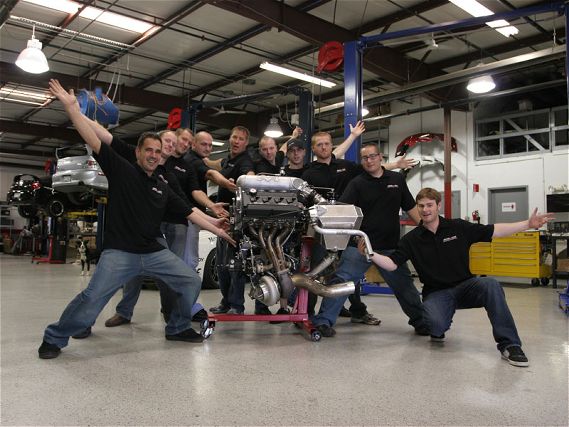 | AMS 4G63 Engine Build - Gunning for Gold
| AMS 4G63 Engine Build - Gunning for Gold
By now you must be very familiar with our participation in the Castrol Syntec Top Shop Challenge. If you just picked up this magazine and need to get up to speed head over to syntectopshopchallenge.com for all the details.
Wrenches have been turning and the dyno has been spinning overtime at AMS' headquarters. With the engine build practically complete, Martin Musial sheds some light on the build and the reasoning behind using the parts we did and the engine's capability.
Building on our years of 4G63 experience and using our engineering strengths, we knew we had to aim high. How high? 1000+ crank horsepower to be exact! A plan started to come together and our parts list began to form. Fortunately we have a strong fabrication department, so all of our crazy ideas could be handled in house.
To make the big horsepower I knew it would take a GT42R based turbo. The tough part of this competition is the 100 octane fuel limit. We normally run VP C16 or VP Import on all the big power cars. We're talking 45-55psi of boost and 1300-1400 crank horsepower out of 4 cylinders. Those fuels are 118 octane or higher, and you can get pretty aggressive with the tune without running into detonation. An engine with high quality forged pistons like the Ross Racing Pistons that we're using will tolerate a certain amount of detonation.
 | AMS 4G63 Engine Build - Gunning for Gold
| AMS 4G63 Engine Build - Gunning for Gold
There are varying degrees of detonation and while most stock engines will rarely put up with anything but mild detonation, you can get a bit more aggressive with stronger components. By no means am I advocating tuning `over the edge' but to get the kind of numbers we're shooting for, we'll be walking a fine line and doing everything we can to keep detonation to a minimum. The first thing to do is keep exhaust backpressure down, this helps keep hot end-gas out of the combustion chamber and also creates more room for a cool fresh intake charge. A quick call to Harry at Precision Turbo and we get on the right track. A GT4202 with a 1.15 A/R turbine housing will keep the exhaust pressure down and a nice set of liquid to air intercooler cores will chill the charge air temps. The 42R is capable of over 1000 hp and is running at peak compressor efficiency around 30-35psi of boost, which is the boost level I'd calculated we'd have to run. We built a custom set of end tanks and water tanks for the liquid to air intercooler and connected the system to a large ice chest. A high flow marine bilge pump sends ice water through the cores and will actually get the intake charge down to below room temperature! For the cam selection I needed a profile that would evacuate as much exhaust gas as possible and prevent any intake charge dilution. Keeping the exhaust backpressure below the intake manifold pressure allows us run some overlap in the cam with little reversion and charge dilution. Like I mentioned before, keeping the intake charge cool, expelling as much exhaust gas as possible, and promoting cylinder filling with fresh charge air is the key to making big power without detonation. Along with new cams, we've also been experimenting with different cylinder head port and valve job designs. We tested different designs and correlated head flow bench data to the horsepower made on the dyno. We can't just look at pure flow numbers on a head and say that it will make more power. The flow rates at low, mid, and high lift have to be tailored to the camshaft and engine combination.
We reached into our stable of test heads and installed what at the time was out best performer. Since then we've eclipsed the test head with an improved design and are currently running a CNC head porting program. With the current AMS CNC head we might have seen another 20-30 horsepower gain but unless you know someone with a sweet Delorean sporting a flux capacitor we're stuck with what we've got. For the bottom end we used custom spec'ed 9.25:1 compression Ross Racing pistons attached to Manley Turbo-Tuff rods. A forged and lightened K1 crank finishes off the reciprocating assembly. One of the only weaknesses of the 4G63 is the oil pump. Not that it's a major problem, but once in a while we'll see the oil pump shaft wearing into the housing and seizing. To avert such problems and add the benefit of drawing crankcase vacuum, we custom fabricated a dry sump system based on a Moroso three stage dry sump oil pump. Two vacuum stages keep the dry sump style oil pan oil free and keep crankcase windage loss down. The plumbing of the oil, coolant, and air fittings is all high quality braided Goodridge lines with AN fittings. Not only does it look good, but there is no chance of leakage or boost lines popping off at high boost. A lot of this project required custom hand fabrication. The raw materials which consisted of flanges, aluminum and stainless piping, and other fabrication necessities came from the Vibrant Performance catalog. Besides the basic roll beading of the intercooler piping we used some trick `boost braces' from Vibrant to prevent any piping from blowing off at boost.
To finish off the induction portion we custom fabricated an intake manifold. The runner length and plenum volume were optimized to meet our horsepower goals. The runners terminate in a bell-horn intake that increases the flow coefficient and ultimately horsepower. A set of 1600 cc/min injectors from PTE sit in our fuel rail and we'll be using most of them up! The final step was the electronics. We gutted a factory harness to simplify things and used only the inputs and outputs that we needed. Controlling the madness is an AEM EMS and a Spark-tech ignition. Since the engine was going to be tuned on an engine dyno, we fabricated a control box that houses all of our vital AEM gauges, the EMS, and various switches to active the electronics and intercooler pump. This way we have a virtual dashboard where we can monitor and control our engine. With the engine build complete we went ahead and installed the engine in our EVO VIII drag car to get some numbers. After establishing a fuel curve with the AEM EMS and conservative ignition timing we were pulling numbers in the 700 whp range on low boost. Everything was working very efficiently and I was impressed with the output. We turned up the boost and started exploring the timing limits. In a matter of a few pulls the dyno showed 830 wheel horsepower! This is through slicks on an all wheel drive car! My opinion on chassis dyno loss is a little bit different than most peoples. I don't believe you can take a straight percentage of loss across the board. I think as you make more power the actual percentage goes down. I'm taking a conservative approach of 15% drivetrain loss, which puts us right under the 1000 crank horsepower mark. I'm waiting until we get on the actual engine dyno before we really push the engine harder and start playing with things like cam timing. I think our goal of 1000 horsepower will be shattered. That's over 500 horsepower per liter of displacement on 100 octane unleaded fuel, pretty amazing that Mitsubishi gave us a platform on which to make such ridiculous horsepower numbers!
It's safe to say that things are looking very positive for the final showdown. That also means anyone who has entered online to win our engine should be a happy camper because if the AMS crew can get the mighty 4G63 dialed in on the engine dyno then winning the Castrol Syntec Top Shop Challenge looks very promising. Stay tuned for the final results!
